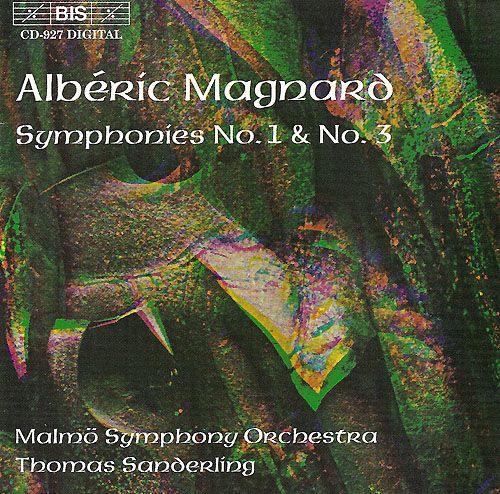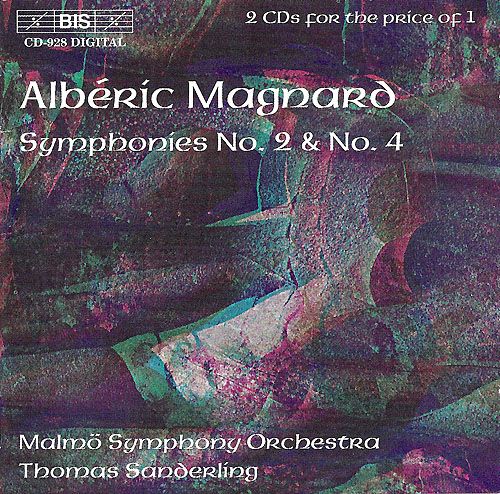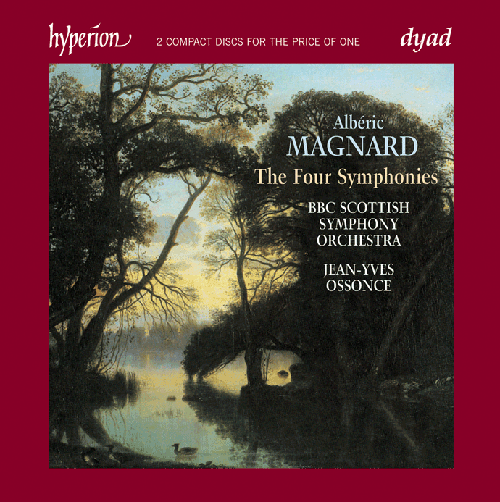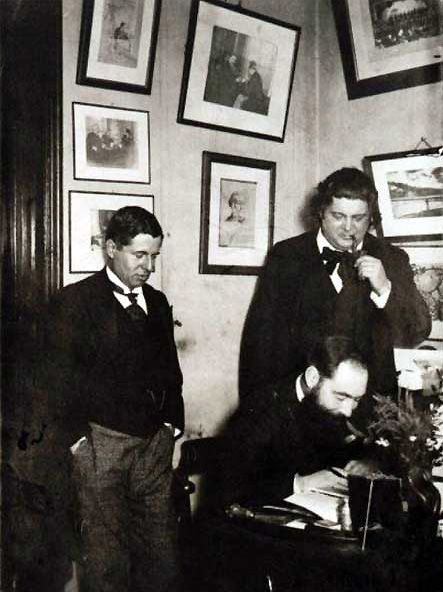wimpel69
12-17-2014, 11:22 AM
FLAC links below. These are my own rips.
Covers & booklets included. Do not share. Buy the originals!
Please leave a "Like" or "Thank you" if you enjoyed this!
Lucien Denis Gabriel Alb�ric Magnard (1865-1914) was a highly individual and inventive composer
who, rather than embracing the new French trend of impressionism, extended his highly Romantic, post-
Wagnerian style into Classical forms. His very touchy, misanthropic personality led to his being largely
overlooked in his own lifetime, waiting until the end of the twentieth century before he started to attain
wide appreciation.
His father was Francis Magnard, a journalist who became editor of Le Figaro, France's top newspaper,
from 1879 to his death in 1894. Magnard's mother died when he was young. He had an easy, upper
middle-class background in which musical training for social (not professional) attainment was standard.
Eventually, he turned against the ease of his station, not hesitating to show his contempt for his
bourgeois class, and seemingly choosing the rougher path whenever the opportunities arose.
After finishing secondary school he lived a monastic life for a while at Ramsgate Abbey in England,
did a tour of military service as an officer, and then entered law school back in France. Although he had
not demonstrated proficiency at an instrument or as a composer, he decided to make music a career,
turning down offers of jobs in journalism from his father or from other journalists who obviously wanted
to curry favor with the powerful elder Magnard.
Like many young Frenchmen of the time, Magnard made the pilgrimage to Wagner's theater and
shrine at Bayreuth, Bavaria, where he was duly bowled over by Tristan und Isolde. Incidentally,
the name he preferred is only coincidentally Wagnerian; it was his godfather's name.
Magnard entered the Conservatoire and studied with Dubois and Massenet. He didn't like either
teacher, but he did graduate with first prize in harmony. He met C�sar Franck and studied for four
years with Vincent d'Indy. He was highly influenced by their music, which showed a tendency to
mix Wagnerian harmony with Classical forms and to rely on cyclic themes (i.e., main musical ideas
that recur from one movement to later ones) in their construction. Magnard adopted this sort
of form, but initially wrote thickly over-orchestrated music, exemplified by his First Symphony.
He also wrote a one-act opera, Yolanda. It was premiered in 1892 in Brussels, while the First
Symphony was first heard in Angers in 1894. He had to endure not-so-quietly whispered
innuendos that these works could not make it on their own merits, but were produced solely to
curry favor with his powerful journalist father. He did not endure these rumors gracefully, and
he developed even more of a tendency to humorlessness and lack of tact and social grace.
In 1894 his father died. Seemingly in reaction to this blow, he wrote his Chant fun�bre, a work
of powerful but severely restrained emotions that seemed to clarify his artistic direction.
In 1896, he became a counterpoint teacher at the Schola Cantorum. In the same year he
married Julia Creton, and set to work on his Second Symphony. At the time of his marriage,
he wrote for her to play a piano suite called Promenades, which is a rare light-hearted piece from
his pen, happily recalling places in Paris they enjoyed together.
Magnard alienated a segment of the public by his reaction to the Dreyfus affair-polarized France.
Magnard, disgusted with the Army's blatant anti-Semitism, publicly resigned his reserve commission.
In 1900, he wrote an opera, Guercoeur, a post-Wagnerian work set in legendary times. During his
life it received only two separate concert performances of one individual act each. It was not
produced on stage or heard in its entirety until April 1931, by which time some parts of it had
gone missing and had to be reconstructed by Magnard's friend, the composer Guy Ropartz.
Failure to get Guercoeur produced further embittered Magnard. In addition, he began to go
deaf. Much as in the case of Beethoven, this made his exterior even more forbidding. It prompted
him to retreat to the quiet and security of his country estate at Baron. In a major career
miscalculation, he fired his publisher because he thought it was unseemly to advertise and publicize
himself. He self-published his music thereafter. Without an agent and publisher to promote and
network his music, he lost opportunities for performance and began to be forgotten except by
his strongest advocates. Still, his chamber music received some performance. Another opera,
B�r�nice, was performed at the Op�ra-Comique in 1911, but again fell flat with an
unprepared public.
In August 1914, when World War I began, Magnard sent his wife and children west for safety,
but he remained at Baron for a while. On September 3, he was working in his study, alone in the
house, when he spotted a troop of German cavalry riding on his estate grounds. He seized his
old Army rifle and shot two of them dead from his upstairs window. The Germans returned fire
and burned down the house, where his body was later found in the ashes. Also lost in the fire
were all existing materials for the opera Yolanda, the full score of two acts of
Guercoeur and a new set of 12 songs.



Music Composed by
Alb�ric Magnard
Played by the
Malm� Symphony Orchestra
BBC Scottish Symphony Orchestra
Conducted by
Thomas Sanderling
Jean-Yves Ossonce
"There’s been a small flurry of recent interest in the music of Alb�ric Magnard, the
finest French symphonist before Tournemire and Roussel. EMI reissued Plasson’s
pioneering recordings of all four symphonies (there was one earlier version of the
Third conducted by Ansermet that is not available on CD in the U.S., though it may
still exist in France), and Hyperion recorded the complete set concurrently with
BIS’s project. This means that fans of the composer already may have acquired
the Hyperion recordings and therefore aren’t interested in this more slowly progressing
series, which would be a pity because Thomas Sanderling’s recordings inarguably
are the best ever in this music. His approach is serious, unremittingly intense, and
trenchant in a way that is markedly more “Germanic” than either Plasson or Ossonce
(Hyperion). But then again, these are very Germanic symphonies–being somewhat
conservative in idiom, tightly written, and keenly balanced between passion and
intellect–so Sanderling’s approach is just what the music demands. His majestic
tempos and firm control of rhythm in places such as the slow movement and finale
of the Third Symphony really give this music a stature and command only hinted
at in other performances. He also has by far the best orchestra and overwhelmingly
the finest recorded sound, so even if you own any of the other versions,
you simply have to hear Sanderling."
Classics Today
"The first two of Magnard’s four symphonies were written under the watchful
eye of d’Indy, and the First Symphony is dedicated to him. The Third Symphony
dates from 1896, the year of Magnard’s marriage to Julia Creton, and the Fourth
was completed in 1913, the year before Magnard’s tragic death. He had settled with
his family at the Manoir des Fontaines in Baron in 1904. After the outbreak of
World War I, he sent his wife and daughters to safety and awaited the German
advance alone. When enemy soldiers entered the grounds one was killed by a
single shot, apparently fired by Magnard, and the Germans set fire to the
house. Magnard apparently died in the blaze, but although the body found
in the ruins could not be identified as his, there was no doubt as to its identity;
the blaze also destroyed many of his manuscripts.
Magnard’s symphonies are colorfully orchestrated and offer the listener a
wonderful play of light and shade and a varied orchestral palette. They are
unrelentingly serious in tone, clear in structure, rhythmically dynamic, and
passionate in expression. Magnard turns his back on the three-movement form
favored by Franck and opts for the traditional four movements. All of his
symphonies contain scherzos that recall rustic dances and they are sometimes
in unusual time signatures (e.g., the 5/4 passages in Symphony No. 3, inspired
by a visit to the Auvergne).
Originally released as two single compact discs, these recordings have meet
with consistent critical acclaim on both sides of the Atlantic. The Independent
called this “An absorbing musical encounter that should spawn its fair share of
Magnard converts,” and the 2009 re-release of the symphonies drew this comment
from Ian Lace, one of my Fanfare colleagues: “These albums compel the
highest recommendation.” To those comments let me append the following:
This is another of those recordings that makes me wonder where this music
has been all these years! The performances by Jean-Yves Ossonce and his
excellent band defy description. The musicians play with energy, commitment,
balance, and poise, going toe-to-toe with the difficulties found in Magnard’s
complex musical canvases and presenting them in eloquent and elegant
readings. These are passionate and sympathetic accounts that bring belated
credit to these rarely heard works. I heartily commend them to the adventurous
listener and the devout Francophile alike. C’est magnifique!"
Fanfare

Alb�ric Magnard (left) with Eug�ne Ysaye (right) &
Joseph-Guy Ropartz (sitting).
Download Link (Sanderling) - https://mega.co.nz/#!HZwWhZLZ!KlaIIFCv1CKxMDGEMTsrmfpq8vQHVlPNTnT6d39 vGQ8
Download Link (Ossonce) - https://mega.co.nz/#!yYYlmCpT!QCDyFniztokWaYxwyfkoIuAqeVRRCOxAzmQnjwD dre8
Source: BIS & Hyperion Records CDs (my rips!)
Format: FLAC(RAR), DDD Stereo, Level: -5
File Sizes: 714 MB (Sanderling) / 575 MB (Ossonce)
Enjoy! Don't share! Buy the origina! Please leave a "Like" or "Thank you" if you enjoyed this! :)
Covers & booklets included. Do not share. Buy the originals!
Please leave a "Like" or "Thank you" if you enjoyed this!
Lucien Denis Gabriel Alb�ric Magnard (1865-1914) was a highly individual and inventive composer
who, rather than embracing the new French trend of impressionism, extended his highly Romantic, post-
Wagnerian style into Classical forms. His very touchy, misanthropic personality led to his being largely
overlooked in his own lifetime, waiting until the end of the twentieth century before he started to attain
wide appreciation.
His father was Francis Magnard, a journalist who became editor of Le Figaro, France's top newspaper,
from 1879 to his death in 1894. Magnard's mother died when he was young. He had an easy, upper
middle-class background in which musical training for social (not professional) attainment was standard.
Eventually, he turned against the ease of his station, not hesitating to show his contempt for his
bourgeois class, and seemingly choosing the rougher path whenever the opportunities arose.
After finishing secondary school he lived a monastic life for a while at Ramsgate Abbey in England,
did a tour of military service as an officer, and then entered law school back in France. Although he had
not demonstrated proficiency at an instrument or as a composer, he decided to make music a career,
turning down offers of jobs in journalism from his father or from other journalists who obviously wanted
to curry favor with the powerful elder Magnard.
Like many young Frenchmen of the time, Magnard made the pilgrimage to Wagner's theater and
shrine at Bayreuth, Bavaria, where he was duly bowled over by Tristan und Isolde. Incidentally,
the name he preferred is only coincidentally Wagnerian; it was his godfather's name.
Magnard entered the Conservatoire and studied with Dubois and Massenet. He didn't like either
teacher, but he did graduate with first prize in harmony. He met C�sar Franck and studied for four
years with Vincent d'Indy. He was highly influenced by their music, which showed a tendency to
mix Wagnerian harmony with Classical forms and to rely on cyclic themes (i.e., main musical ideas
that recur from one movement to later ones) in their construction. Magnard adopted this sort
of form, but initially wrote thickly over-orchestrated music, exemplified by his First Symphony.
He also wrote a one-act opera, Yolanda. It was premiered in 1892 in Brussels, while the First
Symphony was first heard in Angers in 1894. He had to endure not-so-quietly whispered
innuendos that these works could not make it on their own merits, but were produced solely to
curry favor with his powerful journalist father. He did not endure these rumors gracefully, and
he developed even more of a tendency to humorlessness and lack of tact and social grace.
In 1894 his father died. Seemingly in reaction to this blow, he wrote his Chant fun�bre, a work
of powerful but severely restrained emotions that seemed to clarify his artistic direction.
In 1896, he became a counterpoint teacher at the Schola Cantorum. In the same year he
married Julia Creton, and set to work on his Second Symphony. At the time of his marriage,
he wrote for her to play a piano suite called Promenades, which is a rare light-hearted piece from
his pen, happily recalling places in Paris they enjoyed together.
Magnard alienated a segment of the public by his reaction to the Dreyfus affair-polarized France.
Magnard, disgusted with the Army's blatant anti-Semitism, publicly resigned his reserve commission.
In 1900, he wrote an opera, Guercoeur, a post-Wagnerian work set in legendary times. During his
life it received only two separate concert performances of one individual act each. It was not
produced on stage or heard in its entirety until April 1931, by which time some parts of it had
gone missing and had to be reconstructed by Magnard's friend, the composer Guy Ropartz.
Failure to get Guercoeur produced further embittered Magnard. In addition, he began to go
deaf. Much as in the case of Beethoven, this made his exterior even more forbidding. It prompted
him to retreat to the quiet and security of his country estate at Baron. In a major career
miscalculation, he fired his publisher because he thought it was unseemly to advertise and publicize
himself. He self-published his music thereafter. Without an agent and publisher to promote and
network his music, he lost opportunities for performance and began to be forgotten except by
his strongest advocates. Still, his chamber music received some performance. Another opera,
B�r�nice, was performed at the Op�ra-Comique in 1911, but again fell flat with an
unprepared public.
In August 1914, when World War I began, Magnard sent his wife and children west for safety,
but he remained at Baron for a while. On September 3, he was working in his study, alone in the
house, when he spotted a troop of German cavalry riding on his estate grounds. He seized his
old Army rifle and shot two of them dead from his upstairs window. The Germans returned fire
and burned down the house, where his body was later found in the ashes. Also lost in the fire
were all existing materials for the opera Yolanda, the full score of two acts of
Guercoeur and a new set of 12 songs.



Music Composed by
Alb�ric Magnard
Played by the
Malm� Symphony Orchestra
BBC Scottish Symphony Orchestra
Conducted by
Thomas Sanderling
Jean-Yves Ossonce
"There’s been a small flurry of recent interest in the music of Alb�ric Magnard, the
finest French symphonist before Tournemire and Roussel. EMI reissued Plasson’s
pioneering recordings of all four symphonies (there was one earlier version of the
Third conducted by Ansermet that is not available on CD in the U.S., though it may
still exist in France), and Hyperion recorded the complete set concurrently with
BIS’s project. This means that fans of the composer already may have acquired
the Hyperion recordings and therefore aren’t interested in this more slowly progressing
series, which would be a pity because Thomas Sanderling’s recordings inarguably
are the best ever in this music. His approach is serious, unremittingly intense, and
trenchant in a way that is markedly more “Germanic” than either Plasson or Ossonce
(Hyperion). But then again, these are very Germanic symphonies–being somewhat
conservative in idiom, tightly written, and keenly balanced between passion and
intellect–so Sanderling’s approach is just what the music demands. His majestic
tempos and firm control of rhythm in places such as the slow movement and finale
of the Third Symphony really give this music a stature and command only hinted
at in other performances. He also has by far the best orchestra and overwhelmingly
the finest recorded sound, so even if you own any of the other versions,
you simply have to hear Sanderling."
Classics Today
"The first two of Magnard’s four symphonies were written under the watchful
eye of d’Indy, and the First Symphony is dedicated to him. The Third Symphony
dates from 1896, the year of Magnard’s marriage to Julia Creton, and the Fourth
was completed in 1913, the year before Magnard’s tragic death. He had settled with
his family at the Manoir des Fontaines in Baron in 1904. After the outbreak of
World War I, he sent his wife and daughters to safety and awaited the German
advance alone. When enemy soldiers entered the grounds one was killed by a
single shot, apparently fired by Magnard, and the Germans set fire to the
house. Magnard apparently died in the blaze, but although the body found
in the ruins could not be identified as his, there was no doubt as to its identity;
the blaze also destroyed many of his manuscripts.
Magnard’s symphonies are colorfully orchestrated and offer the listener a
wonderful play of light and shade and a varied orchestral palette. They are
unrelentingly serious in tone, clear in structure, rhythmically dynamic, and
passionate in expression. Magnard turns his back on the three-movement form
favored by Franck and opts for the traditional four movements. All of his
symphonies contain scherzos that recall rustic dances and they are sometimes
in unusual time signatures (e.g., the 5/4 passages in Symphony No. 3, inspired
by a visit to the Auvergne).
Originally released as two single compact discs, these recordings have meet
with consistent critical acclaim on both sides of the Atlantic. The Independent
called this “An absorbing musical encounter that should spawn its fair share of
Magnard converts,” and the 2009 re-release of the symphonies drew this comment
from Ian Lace, one of my Fanfare colleagues: “These albums compel the
highest recommendation.” To those comments let me append the following:
This is another of those recordings that makes me wonder where this music
has been all these years! The performances by Jean-Yves Ossonce and his
excellent band defy description. The musicians play with energy, commitment,
balance, and poise, going toe-to-toe with the difficulties found in Magnard’s
complex musical canvases and presenting them in eloquent and elegant
readings. These are passionate and sympathetic accounts that bring belated
credit to these rarely heard works. I heartily commend them to the adventurous
listener and the devout Francophile alike. C’est magnifique!"
Fanfare

Alb�ric Magnard (left) with Eug�ne Ysaye (right) &
Joseph-Guy Ropartz (sitting).
Download Link (Sanderling) - https://mega.co.nz/#!HZwWhZLZ!KlaIIFCv1CKxMDGEMTsrmfpq8vQHVlPNTnT6d39 vGQ8
Download Link (Ossonce) - https://mega.co.nz/#!yYYlmCpT!QCDyFniztokWaYxwyfkoIuAqeVRRCOxAzmQnjwD dre8
Source: BIS & Hyperion Records CDs (my rips!)
Format: FLAC(RAR), DDD Stereo, Level: -5
File Sizes: 714 MB (Sanderling) / 575 MB (Ossonce)
Enjoy! Don't share! Buy the origina! Please leave a "Like" or "Thank you" if you enjoyed this! :)